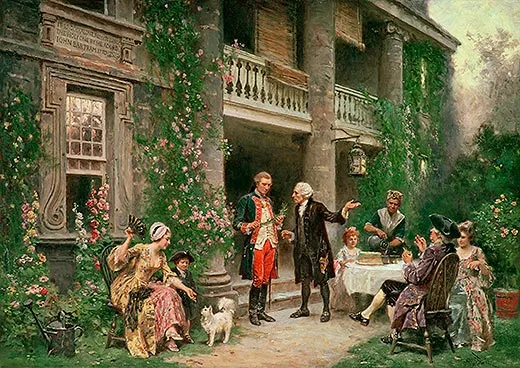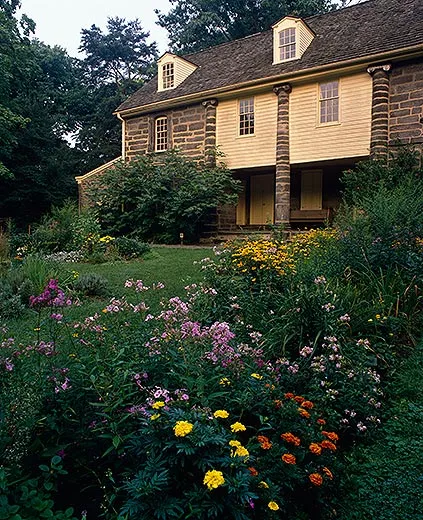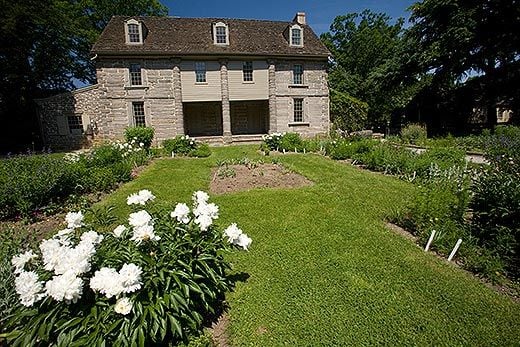The Story of Bartram’s Garden
Outside of Philadelphia, America’s first botanical garden once supplied seeds to Founding Fathers and continues to inspire plant-lovers today
/https://tf-cmsv2-smithsonianmag-media.s3.amazonaws.com/filer/George-Washington-at-Batrams-Garden-631.jpg)
When George Washington visited the Bartram family’s prestigious garden near Philadelphia in 1787, he found it to be “not laid off with much taste.”
To naturalists like the Bartrams, however, the flora took precedence over the layout. Their 102-acre spread sloping down to the Schuylkill River was a grand incubator of native plants and the first botanical garden in the United States. Here, John Bartram and his sons William and John Jr. planted specimens they gathered from a large swath of the New World to be sold in the Old World. They are credited with creating the country’s first plant catalog in 1783, a 22-by-17-inch sheet of paper with almost 220 “trees, shrubs, and herbacious plants.” To round out this horticultural enterprise, the Bartrams also ran a nursery. The Bartrams sent seeds to Thomas Jefferson for planting at Monticello and in 1784, the Continental Congress adjourned specifically to visit Bartram’s garden.
Today their green emporium is a 45-acre park that encompasses the Bartram family home, several outbuildings, a cider press, and trails that wind through woods and meadows and along the river. The large gingko on the home’s north side was probably a sapling when John was alive; a few yards away stands a yellowwood tree that William himself could have planted in 1790 after French botanist Andre Michaux gave it as a gift.
Beginning in the 18 century, the Bartram name became synonymous with botany in part because of John Sr.’s passion for the plant life around him and in part—perhaps—because he was a frustrated doctor.
“His own accounts of his life say he wanted to study medicine,” says Joel T. Fry, curator at Bartram’s Garden. “But there were no medical schools here.” Instead, John taught himself about plants through reading and first-hand observation.
John was also a Quaker, a denomination that produced many naturalists at the time, Fry explains. “The Quakers saw God in themselves and in nature,” he continued. “They encouraged children to study plants and medicine. An awful lot of the new plants found here had properties that could provide cures.”
Those plants were not cheap. Most clients were wealthy Europeans keen to reforest their estates with American trees and shrubs, horticultural status symbols in the 18th and 19th centuries. In January or February—the cusp of planting season—the 3-by 2 ½-foot “Bartram boxes” arrived full of live plants and seeds packed in sand or moss; a few of the specimens came in paper, but that was a rare commodity.
“You could get 5 or 12 magnolia seeds and 25 to 50 pine cones,” Fry said. Other American beauties included orchids, mountain laurels, and rhododendrons (azaleas). The latter shrubs are now common in England. Descendants of several that arrived in 1748 flourish on the grounds of Painshill Park in Surrey.
To get their stock, John Sr. and William went far, from Florida to the Ohio River. They usually went by horseback, but occasionally they’d use canoes or sloops. On a Georgia riverbank in 1765, they discovered the Franklinia tree, which they named after John Sr.’s friend Benjamin Franklin. The tree was never seen in the wild after 1803, and exists today only because the Bartrams propagated and distributed it.
William himself spent almost four years traveling throughout the South, describing both in words and artwork what he saw. The journals he kept became Travels Through North & South Carolina, Georgia, East & West Florida, a classic of American nature literature that stands alongside works by Thoreau, Audubon and Muir.
The Bartrams propagated over 4,000 native and exotic plants. Initially only hardy or semi-hardy varieties could survive back in Philadelphia. They sheltered the tenderest ones any way they could, with leaves, walls, pits, and cold frames. Then in 1760, John built the garden’s first greenhouse; by 1830, there were ten.
The only greenhouse that that remains today is a small room in the main house that was used by John Jr.’s daughter Ann Carr. She and her husband, Robert, ran the family business from 1812 until financial constraints forced then to sell in 1850. The next owner, railroad magnate Andrew Eastwick, grew up playing on the grounds. “My dearest hope is that the garden shall be preserved forever,” he wrote about his new property.
After Eastwick died in 1879, Bartram’s garden became a neglected wilderness in what had turned into an industrial part of town. As the result of a campaign to preserve the property led by Thomas Meehan—Eastwick’s former gardener and a member of the Philadelphia City Council—the grounds were successfully added to the city’s park system in 1891. The house became a National Historic Landmark in 1963.
Today, Fry and the park’s gardeners are rethinking the paths that course through the gardens near the house so they better reflect what would have been there in the Bartrams’ heyday. Volunteers harvest seeds from plants and pack them up for sale in the gift shop. Several beehives on the grounds produce honey that's sold in the gift shop. Picnicking is encouraged. And from April through October, the Bartram homestead is open for guided tours.
“Whatsoever whether great or small ugly or hansom sweet or stinking,” John Sr. wrote around 1740, “…everything in the universe in thair own nature appears beautiful to me.”



